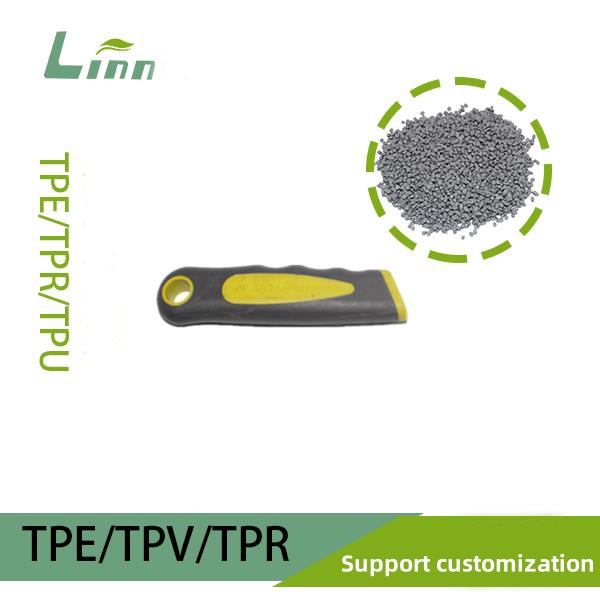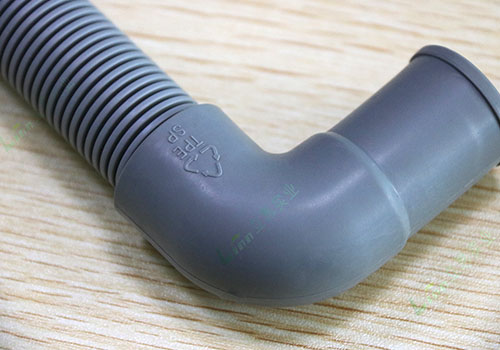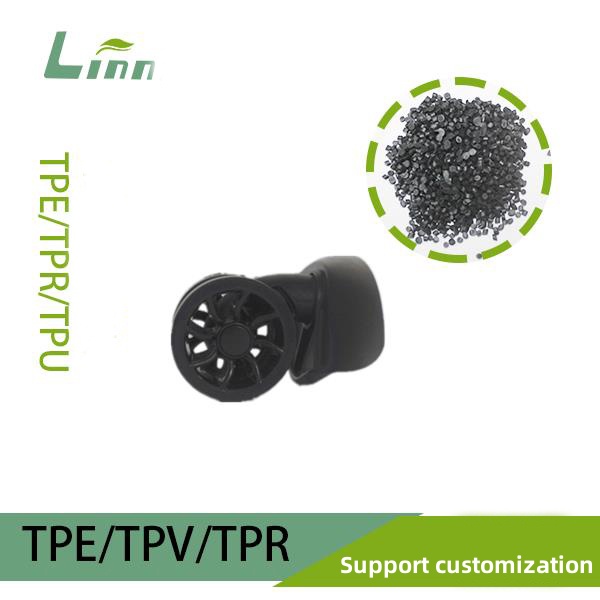Before we get into why TPE hardens, let’s start with the basics. Thermoplastic elastomers (TPE) are a unique class of materials that combine the elasticity of rubber with the processability of plastics. They’re widely used in industries like automotive, medical devices, consumer electronics, and sporting goods. TPE’s popularity stems from its ability to be both soft and flexible like rubber while being moldable like plastic through processes such as injection molding or extrusion.

TPE’s molecular structure typically consists of soft segments and hard segments:
Soft segments: These provide elasticity and are usually made of flexible chains like polyether or polyester.
Hard segments: These contribute strength and rigidity, often composed of polystyrene (PS) or polypropylene (PP).
This combination of soft and hard segments gives TPE its characteristic flexibility and elasticity at room temperature. However, when exposed to high temperatures, TPE’s properties can change, sometimes resulting in hardening. Let’s explore why this happens.
Why Does TPE Harden at High Temperatures?
The hardening of TPE at high temperatures can be attributed to changes at both the molecular and macroscopic levels. I’ll break it down into several key factors:
1. Molecular Reorganization and Crystallization
At room temperature, TPE’s soft and hard segments maintain a delicate balance. The soft segments provide flexibility, while the hard segments offer structural support. When TPE is exposed to high temperatures (typically above its glass transition temperature, Tg, or melting point, Tm), molecular chains become more mobile, leading to:
Hard segment reorganization: The hard segments, such as polystyrene or polypropylene, may undergo partial crystallization. This tighter molecular arrangement increases rigidity and reduces flexibility.
Soft segment degradation: The soft segments, like polyether, may experience chain scission or oxidative degradation at high temperatures, resulting in a loss of elasticity and overall hardening.
For example, I once worked with a manufacturer of TPE phone cases who noticed that their products became stiff after being transported in high temperatures during summer, reaching up to 60°C. Testing revealed that the elevated temperature exceeded the TPE’s Tg, causing the hard segments to crystallize and the material to lose its softness.

2. Impact of Fillers and Additives
TPE formulations often include fillers (e.g., calcium carbonate) and additives (e.g., plasticizers, antioxidants) to enhance performance. High temperatures can affect these components in ways that contribute to hardening:
Plasticizer volatilization: Plasticizers, which make TPE soft, may evaporate or break down at high temperatures, leading to a stiffer material.
Filler agglomeration: Elevated temperatures can cause filler particles to clump together, disrupting the material’s uniformity and making it feel harder.
I once assisted a medical device company with an issue where their TPE infusion tubes hardened after high-temperature sterilization. We found that the loss of plasticizers during the process was the primary culprit. Adjusting the formulation resolved the issue significantly.
3. Thermal Aging and Oxidation
High temperatures often go hand in hand with oxygen exposure, which can trigger thermal aging in TPE. During thermal aging, the material undergoes:
Oxidation reactions: Oxygen reacts with TPE’s molecular chains, forming carbonyl or hydroxyl groups, which can cause chain scission or crosslinking.
Crosslinking reactions: Some TPEs may undergo irreversible chemical crosslinking at high temperatures, transforming the material from an elastomer to a more rigid plastic.
The result of thermal aging is often a brittle, hardened material, sometimes with surface cracks. In one experiment, I observed that a TPE sample without sufficient antioxidants increased in hardness from Shore A 60 to Shore A 80 after 48 hours in an 80°C oven, with almost complete loss of elasticity.
4. Influence of Processing Conditions
Sometimes, TPE hardening isn’t due to the material itself but rather improper processing techniques. Common issues include:
Excessive processing temperatures: Overheating during injection molding or extrusion can degrade TPE’s molecular chains or induce hard segment crystallization.
Improper cooling rates: Rapid cooling may lock in molecular stresses, leading to “post-crystallization” during subsequent high-temperature exposure, which manifests as hardening.
I once helped a toy manufacturer optimize their TPE processing by lowering the injection molding temperature and adjusting cooling times, effectively eliminating hardening issues after high-temperature storage.

Common Scenarios and Data Analysis of TPE Hardening
To provide a clearer picture, I’ve compiled a table summarizing typical scenarios where TPE hardens, along with their causes, effects, and hardness changes:
|
Scenario |
Possible Cause |
Effect |
Hardness Change (Shore A) |
|---|---|---|---|
|
High-temperature transport (e.g., summer trucks) |
Hard segment crystallization, plasticizer volatilization |
Loss of flexibility, hardened texture |
60 → 75 |
|
High-temperature sterilization (e.g., medical devices) |
Plasticizer volatilization, thermal aging |
Brittle material, possible cracking |
55 → 80 |
|
Long-term high-temperature storage (e.g., warehouses) |
Thermal aging, oxidative crosslinking |
Loss of elasticity, sticky or hardened surface |
65 → 85 |
|
Excessive processing temperature (e.g., injection molding) |
Molecular chain degradation, hard segment reorganization |
Unstable initial properties, later hardening |
50 → 70 |
Data source: Personal experiments and industry case studies; hardness changes are approximate and depend on TPE formulation.
As the table shows, the causes and severity of hardening vary by scenario, but they all tie back to temperature-induced molecular changes.
How to Address TPE Hardening at High Temperatures?
Now that we understand why TPE hardens, let’s focus on solutions. Here are practical strategies to prevent or mitigate TPE hardening, tailored for different users:
1. Optimize TPE Formulation
Select high-temperature-resistant base materials: Choose TPEs with higher Tg or Tm, such as those based on SEBS (styrene-ethylene-butylene-styrene), which offer better heat resistance.
Incorporate antioxidants: Add effective antioxidants (e.g., hindered phenols or phosphites) to slow thermal aging.
Use high-temperature-resistant plasticizers: Opt for low-volatility plasticizers, such as high-molecular-weight polyester plasticizers.
For instance, I recommended that a yoga mat manufacturer add 0.5% antioxidant 1010 to their TPE formulation. This reduced hardness changes after high-temperature storage from 15 Shore A to just 5 Shore A.
2. Improve Processing Techniques
Control processing temperatures: Keep injection molding or extrusion temperatures within the supplier’s recommended range, typically 180-220°C.
Optimize cooling processes: Use gradual cooling to avoid molecular stress buildup.
Minimize reprocessing: Repeated heating can exacerbate molecular degradation, so reduce rework whenever possible.
3. Design for Appropriate Use Environments
Avoid prolonged high-temperature exposure: During transport or storage, maintain temperatures below the TPE’s Tg (usually 50-80°C).
Implement protective measures: For medical devices undergoing high-temperature sterilization, select heat-resistant TPE grades or apply protective coatings.

4. Conduct Regular Testing and Validation
Thermal aging tests: Simulate high-temperature conditions (e.g., 80°C for 72 hours) during product development to assess TPE performance.
Hardness and elasticity testing: Routinely measure Shore A hardness and tensile properties to ensure compliance with requirements.
I once designed a high-temperature aging test protocol for an automotive parts supplier, testing at 60°C for 100 hours. This helped them select the most heat-resistant TPE formulation, significantly reducing customer complaints.
Real-World Case Study: From Problem to Solution
To make this more relatable, let me share a real case I worked on. Last year, a client producing TPE sealing strips contacted me about a problem: their seals hardened after prolonged use in high-temperature environments (around 50-60°C) during summer, leading to poor sealing performance and frequent customer complaints.
After analysis, we identified the following issues:
The TPE formulation had a high plasticizer content with significant volatility.
Processing temperatures were too high (230°C), causing partial molecular chain degradation.
The product hadn’t undergone sufficient high-temperature aging tests.
We implemented these solutions:
Adjusted the formulation to reduce plasticizer content and incorporate a heat-resistant SEBS base.
Lowered the injection molding temperature to 200°C and optimized cooling times.
Added a high-temperature aging test (60°C for 48 hours) before shipping to ensure performance stability.
As a result, the seals’ hardness change in high-temperature conditions dropped from 20 Shore A to 5 Shore A, sealing performance improved dramatically, and customer satisfaction soared.

Frequently Asked Questions: Addressing Your Concerns
To further assist, I’ve compiled answers to common questions about TPE hardening:
Q1: Do all TPEs harden at high temperatures?
A: Not all TPEs harden. The heat resistance varies depending on the formulation and base material. For example, SEBS-based TPEs generally perform better at high temperatures than SBS-based ones. Choosing the right TPE grade for your environment is critical.
Q2: Can TPE regain its softness after hardening?
A: If hardening results from plasticizer loss or mild crystallization, cooling the material may partially restore softness. However, severe thermal aging or crosslinking makes recovery unlikely.
Q3: How can I tell if a TPE is suitable for high-temperature environments?
A: Check the TPE’s technical data sheet (TDS) for its Tg, Tm, and temperature resistance range. Additionally, conduct thermal aging tests to simulate real-world conditions.
Q4: Does TPE hardening affect its safety?
A: In most cases, hardening doesn’t cause TPE to release harmful substances, so safety remains intact. However, for medical or food-contact applications, ensure the material complies with standards like FDA or ISO 10993.
Q5: Are there alternatives to TPE for high-temperature applications?
A: For higher temperature requirements, consider silicone rubber (resistant up to 200°C) or thermoplastic polyurethane (TPU, slightly more heat-resistant than TPE). However, these materials may be costlier or harder to process.
Final Thoughts
TPE hardening at high temperatures is a common but manageable challenge. By understanding the molecular changes, optimizing formulations and processing, and designing for appropriate environments, we can ensure TPE maintains its excellent properties even under heat. As a materials professional, I find these challenges fascinating—they remind me that behind every problem lies an opportunity to apply science and creativity.
If you’re dealing with TPE hardening or similar issues, feel free to try the solutions I’ve shared or reach out with your specific situation—I’d be happy to help analyze and troubleshoot. I hope this article has been insightful, and please feel free to share it with others who might find it useful!





